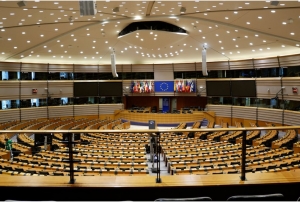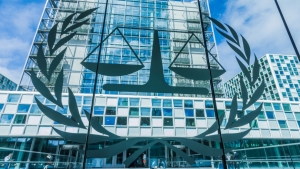Pode a Corte Internacional de Justiça (‘Corte’ ou ‘CIJ’) pronunciar-se significativamente sobre as obrigações dos Estados em relação às mudanças climáticas?
[English version below]
Essa é a aposta dos 105 Estados co-patrocinadores (numa iniciativa liderada pela República de Vanuatu) de um pedido de opinião consultiva aprovado por consenso no dia 29 de março de 2023 na Assembleia Geral da Organização das Nações Unidas (ONU). Esse ensaio visa a analisar o pedido de opinião feito pela Assembleia Geral, destacando a formulação das questões e a estratégia empregada pelos Estados para obter uma pronúncia autoritativa do principal órgão judiciário da ONU. Brasil não foi um dos co-patrocinadores originais mas outros Estados latino-americanos o foram como Chile, Colômbia, Costa Rica e outros.
Após uma série de modificações e negociações internas entre os co-patrocinadores num longo período de cunhagem dos termos das perguntas – que efetivamente ambicionam direcionar uma resposta efetiva da Corte e evitar uma resposta ampla que pudesse ser redimensionada – a Resolução A/77/L.58 formulou as seguintes questões à CIJ:
(a) Quais são as obrigações dos Estados sob o direito internacional para garantir a proteção do sistema climático (‘climate system’) e de outras partes do meio ambiente contra as emissões antropogênicas de gases de efeito estufa (GEE) para os Estados e para as gerações presentes e futuras?
(b) Quais são as consequências jurídicas dessas obrigações para os Estados que, por suas ações e omissões, tenham causado danos significativos ao sistema climático e a outras partes do meio ambiente, em relação a:
(i) Estados, incluindo, em particular, pequenos Estados insulares em desenvolvimento, que devido às suas circunstâncias geográficas e nível de desenvolvimento, são prejudicados ou especialmente afetados ou são particularmente vulneráveis aos efeitos adversos da mudança climática?
(ii) Povos e indivíduos das gerações presentes e futuras afetados pelos efeitos adversos das mudanças climáticas? [1]
Não seria exagerado afirmar que cada termo e construção frasal do pedido de opinião foi cuidadosamente escolhido e que possui uma específica finalidade. Antes de analisar os pedidos em si (B), e brevemente especular sobre o eventual significado da pronúncia da Corte (C) é necessário frisar alguns elementos contextuais que podem lançar luz às normas internacionais envolvidas no processo de pronúncia da Corte (A).
- Quais normas podem estar envolvidas no pedido de Opinião?
Se a maioria das obrigações internacionais positivadas diretamente endereçando mudanças climáticas impondo condutas a Estados encontram-se na Convenção-Quadro das Nações Unidas sobre Mudança do Clima (UNFCCC), o Protocolo de Kyoto, no Acordo de Paris de 2015 e nos compromissos posteriormente assumidos também nas declarações das contribuições nacionalmente determinadas (NDCs), existe um conjunto de outras normas internacionais que podem se provar particularmente relevantes para responder ao questionamento da Corte.
Diferentemente da Opinião Consultiva de 1996 sobre a Legalidade de Ameaça ou Uso de Armas Nucleares em que uma lacuna jurídica existia e uma celeuma em relação ao conteúdo do direito dividia os Estados, a formulação da primeira parte da pergunta no Pedido de Opinião sobre Mudanças Climáticas é razoavelmente mais ampla. Não por acaso a maioria dessas normas foram referenciadas nos parágrafos introdutórios da própria opinião: os principais tratados multilaterais ambientais foram mencionados (Convenção da Biodiversidade, Desertificação, Proteção da Camada de Ozônio, entre outros), bem como as principais convenções envolvendo direitos humanos. A inserção das obrigações de direitos humanos parece constituir uma novidade na medida que a prática recente dos órgãos internacionais (principalmente a Assembleia Geral e o Conselho de Direitos Humanos) tem conectado os impactos da degradação climática e ambiental ao gozo de direitos humanos. O reconhecimento do direito humano ao meio ambiente saudável desempenha um papel particularmente importante na resolução e no debate na medida em que grande parte do seu conteúdo ainda está por ser definido pela prática internacional.
O pedido de opinião parece sugerir que, ao responder a “(a) quais são as obrigações dos Estados sob o direito internacional para…” uma leitura holística desses instrumentos possa oferecer esclarecimentos sobre o atual cenário de obrigações que Estados possuem tanto em relação a outros Estados como também em relação a seus indivíduos (pergunta b, ii). Mais do que isso, uma parte do pedido de opinião enfatiza a importância de “princípios relevantes e obrigações relevantes do direito internacional consuetudinário (…) para a conduta dos Estados ao longo do tempo em relação a atividades que contribuem para a mudança climática e seus efeitos adversos”. Nesse ponto, a maneira como a Corte identificar as obrigações costumeiras do direito internacional presentes na Declaração de Estocolmo e na Declaração do Rio e sua aplicação no contexto de mudança climática pode constituir efetivamente inovação na matéria, em especial se conectada com os deveres de diligência devida já estabelecidos em sua jurisprudência (e.g. casos Pulp Mills e Costa Rica v Nicaragua/Nicaragua v Costa Rica). Ao se considerar as obrigações de diligência e algumas obrigações de conduta presentes no Acordo de Paris, como o dever de não-regressão, por exemplo, a Corte poderia chegar ao detalhamento de obrigações presentes em diferentes tratados internacionais, conectando regimes jurídicos hoje em isolamento exceto por princípios gerais.
De uma certa forma, a lógica interpretativa que parece guiar os solicitantes da opinião é que a emergência climática declarada cientificamente pelo Painel Intergovernamental de Mudanças Climáticas e reconhecido na Resolução da Assembleia Geral “Proteção do clima global para as gerações presentes e futuras da humanidade” (A/RES/77/165) de 14 de dezembro de 2022 poderia gerar uma nova interpretação dos instrumentos jurídicos já existentes no cenário internacional. Uma interpretação do gênero não ocorrerá sem alguma divisão dos Estados (e provavelmente Organizações Internacionais) durante as fases escrita e oral que possivelmente se seguirão após o recebimento do pedido de Opinião pela Corte.
- O que os Estados (e a Assembleia) desejam juridicamente esclarecer?
Se a primeira parte da pergunta parece exigir como resposta uma lista de obrigações e sua aplicabilidade num contexto de mudanças climáticas, em especial as obrigações de caráter costumeiro, a segunda parte da pergunta entra num ponto em que parece existir efetiva controvérsia entre diferentes stakeholders da comunidade internacional. Isto porque ela é voltada às consequências jurídicas, por ação ou omissão, de estados que tenham causado dano significativo ao “sistema climático e outras partes do meio ambiente”. Ou seja, fala-se de responsabilização internacional.
Nesse ponto, as idealizadoras da pergunta foram particularmente felizes ao não incluir unicamente o regime de alterações das características da totalidade da atmosfera, hidrosfera, biosfera e geosfera e suas interações (Art. 1 3, UNFCCC), mas também seus impactos em outros regimes ambientais anteriormente reconhecidos internacionalmente. Desse modo, caso a CIJ responda a essa pergunta, poderá se manifestar sobre um regime de responsabilidade internacional tanto difuso (‘sistema climático’) quanto concentrado (‘biodiversidade’, p. ex). Ou seja, a depender do conteúdo da opinião da Corte, não será apenas uma opinião sobre o direito internacional das mudanças climáticas, mas uma opinião consultiva sobre o direito internacional ambiental como um todo.
A pergunta não é desprovida de problemas para a definição da Corte como, por exemplo, o que seria um “dano significativo” ao sistema climático. Esses problemas porém podem constituir uma oportunidade para a CIJ, sem avançar demais no campo da legislação judicial, clarificar conceitos já utilizados no campo da responsabilidade internacional anteriormente desenvolvidos pelos Estados, como por exemplo no âmbito da Comissão de Direito Internacional.
Além do potencial de esclarecer as consequências de eventuais violações de Estados por ação ou omissão de obrigações internacionais relativas à proteção do sistema climático e outras partes do meio ambiente a gerações presentes e futuras, a subramificação da questão (b) é particularmente relevante na medida em que identifica dois grupos especiais para os quais os formuladores da pergunta parecem identificar consequências especiais. Em primeiro lugar, os Estados insulares. Mas não apenas. A lógica parece ser de que Estados insulares “devido às suas circunstâncias geográficas” e “nível de desenvolvimento”, acabam por ser “prejudicados ou especialmente afetados ou são particularmente vulneráveis aos efeitos adversos da mudança climática”. Ao tecer consequências a essa categoria de Estados, a Corte poderá contribuir efetivamente à noção de justiça climática e, utilizando-se do princípio costumeiro de responsabilidades comuns mas diferenciadas refletido no Princípio 7 da Declaração do Rio, identificar como o conteúdo desse princípio impõe ou não responsabilidades especiais dos Estados desenvolvidos para os Estados em desenvolvimento.
A segunda subramificação da questão (b) diz respeito às consequências jurídicas para povos e indivíduos (de gerações presentes e de gerações futuras). Também aqui os formuladores do pedido de opinião pareceram particularmente bem sucedidos em pedir esclarecimentos das consequências numa dimensão individual e coletiva, para além da dimensão interestatal. Com essa pergunta, a Corte poderá não apenas concentrar-se nas obrigações recíprocas dos Estados entre si, mas nas obrigações que Estados possuem com indivíduos e grupos de indivíduos no interior de sua jurisdição e, dada a própria natureza da questão climática, também extraterritoriais.
- Pode a CIJ pronunciar-se significativamente?
Existem dúvidas sobre a Corte Internacional de Justiça, tradicionalmente percebida como um tribunal internacional estadocêntrico e, em muitos casos, de profícua contenção judicial, pronunciar-se significativamente sobre os questionamentos a ela colocados. Embora pouco fundada, existe a possibilidade que a Corte altere o conteúdo da questão (como já fez no passado, p. ex na Opinião sobre Kosovo) ou delimite o escopo da pergunta apenas à identificação das regras existentes, sem avançar qualquer interpretação nova sobre responsabilização, deveres dos Estados desenvolvidos em relação aos estados em desenvolvimento sobre cooperação e tecnologia para adaptação e mitigação das mudanças climáticas. Certamente a Corte está ciente de que sua pronúncia nesse momento, apesar de não obrigatória, será dotada de grande autoridade e utilizada em casos contenciosos futuros em diversas instâncias. Isto porque opiniões consultivas são autoritativas pelo conteúdo do direito que identificam, não pelo receptáculo jurisdicional que as involucram. Seja como for, se os dois polos possíveis da Corte se mover são o ativismo judicial – em que avança interpretações sobre as regras existentes de maneira a transformar os regimes climáticos em instrumentos vivos de proteção e litigância – e a autocontenção judicial – em que meramente identifica obrigações – há muitos fatores que irão influenciar a posição da Corte.
Uma pronúncia significativa dependerá significativamente da manifestação dos Estados e eventualmente de organizações internacionais (em recente procedimento envolvendo Israel, a Corte permitiu a participação da Liga dos Estados Árabes e a Organização da Cooperação Islâmica a participar). Se 103 Estados dispuseram-se a participar do pedido de opinião consultiva, e dada à generalidade das perguntas feitas, é possível esperar uma alta participação. Essa participação poderá variar entre questões procedimentais e materiais. Nas questões procedimentais, pode-se esperar manifestações envolvendo a formulação da pergunta, a discricionariedade da Corte em responder à opinião ou ainda a competência da Corte para se manifestar sobre temas em constante negociação pelos Estados. Desnecessário afirmar, há Estados que não desejam uma pronúncia troppo elaborada da CIJ e a melhor maneira de evitá-la e fazer com que jamais exista. A Corte teria poder para declinar a resposta à pergunta – mas nunca o fez. Em verdade, em sua recente jurisprudência, é possível notar uma leve expansão na própria percepção da função consultiva da Corte. Sobre esses pontos procedimentais, talvez pese o fato de que a resolução foi adotada por consenso e patrocinada por um alto número de Estados de diferentes grupos do sistema ONU pese para sua superação.
Nas questões materiais, também é possível esperar um alto número de variações de teses jurídicas formuladas pelos Estados. Pode também existir alguma divisão entre Estados desenvolvidos e em desenvolvimento assumindo interpretações diversas em relação aos deveres de reparação e eventualmente, reproduzindo as lógicas de divisão assistidas nas conferências das partes dos acordos climáticos. Como de costume, a Corte sopesará a força desses argumentos e sua contundência. Ao Brasil, mais uma vez apresenta-se a ocasião de participar ativamente numa opinião consultiva, aumentando seu perfil de rulemaker através de procedimentos judiciais.
Corre contra a causa o fato de que os tempos não são abundantes. Na última opinião consultiva emitida pela Corte envolvendo uma grande questão como a autodeterminação dos povos sobre as Consequências Jurídicas da Separação do Arquipélago de Chagos, a Assembleia Geral adotou a resolução em junho de 2017 e em 1 março de 2018 Estados tiveram de apresentar suas alegações escritas (após extensão do prazo) em março de 2018 e comentários às outras alegações em maio de 2018. Audiências ocorreram em setembro de 2018 e a Corte emitiu sua opinião em 25 de fevereiro de 2019. A Corte e seu secretariado terão certamente um desafio para gerenciar essa participação e a eventual participação indireta da sociedade civil na opinião consultiva. Assim como Estados terão o desafio de coordenar seus posicionamentos de política externa jurídica tanto em relação às outras duas opiniões consultivas em curso (perante o Tribunal Internacional do Direito do Mar e à Corte Interamericana de Direitos Humanos).
Responsabilidades comuns mas diferenciadas, equidade intergeracional, direito humano ao meio ambiente saudável. Noções avançadas de direito internacional ambiental que se desenvolveram rapidamente nos últimos 30 anos no interior da ciência jurídica internacional estão diante de um dos maiores e mais emblemáticos casos perante a Corte da Haia. Independente de qual for o resultado desse processo – do ativismo judicial à autocontenção – devido à emergência climática na qual se vive ele parece ter já se inscrito nos anais da história do direito internacional. A depender do quão significativa e autoritativa for a pronúncia da Corte também aumenta-se a sua percepção enquanto ator no combate aos desafios impostos pelas mudanças climáticas à comunidade internacional como um todo.
The Request for an Advisory Opinion on Climate Change before the International Court of Justice
Can the International Court of Justice (‘Court’ or ‘ICJ’) make a significant pronouncement on the obligations of States in relation to climate change?
That is the wager of the 105 co-sponsoring states (in an initiative led by the Republic of Vanuatu) of a request for an advisory opinion approved by consensus on March 29, 2023 at the United Nations General Assembly (UNGA). This essay aims to analyze the request for opinion made by the General Assembly, highlighting the wording of the questions and the strategy employed by states to obtain an authoritative pronouncement from the UN’s main judicial body. Brazil was not one of the original co-sponsors, but other Latin American states were, such as Chile, Colombia, Costa Rica, and others.
After a series of internal modifications and negotiations among the co-sponsors over a long period of coining – which effectively aspire to direct an effective response from the Court and avoid a broad answer that could be scaled back – Resolution A/77/L.58 formulated the following questions to the ICJ:
(a) What are the obligations of States under international law to ensure the protection of the climate system and other parts of the environment from anthropogenic greenhouse gas (GHG) emissions for States and for present and future generations?
(b) What are the legal consequences of these obligations for States where, by their acts and omissions, they have caused significant damage to the climate system and other parts of the environment, with respect to:
(i) States, including in particular small island developing States, which because of their geographic circumstances and level of development are harmed or especially affected by or are particularly vulnerable to the adverse effects of climate change?
(ii) People and individuals of present and future generations affected by the adverse effects of climate change?
It would not be an exaggeration to state that each term and phrasal construction of the opinion request has been carefully crafted and that it has a specific purpose. Before analyzing the requests themselves (B), and briefly speculating on the eventual significance of the Court’s pronouncement (C) it is necessary to stress some contextual elements that may shed light on the international norms involved in the Court’s pronouncement process (A).
What norms might be involved in the request for an Opinion?
While most of the positive international obligations directly addressing climate change by imposing conduct on states are found in the United Nations Framework Convention on Climate Change (UNFCCC), the Kyoto Protocol, the 2015 Paris Agreement, and the commitments subsequently made also in nationally determined contribution (NDC) declarations, there are a number of other international norms that may prove particularly relevant to address the Court’s questioning.
Unlike the 1996 Advisory Opinion on the Legality of the Threat or Use of Nuclear Weapons in which a legal lacuna existed and a kerfuffle regarding the content of the right divided State proved itself, the wording of the first part of the question in the Request for Opinion on Climate Change is reasonably broader. Not coincidentally most of these norms were referenced in the introductory paragraphs of the opinion itself: the main multilateral environmental treaties were mentioned (Biodiversity Convention, Desertification, Ozone Layer Protection, among others), as well as the main conventions involving human rights. The insertion of human rights obligations seems to constitute a novelty as the recent practice of international bodies (mainly the General Assembly and the Human Rights Council) which have connected the impacts of climate and environmental degradation on the enjoyment of human rights. The recognition of the human right to a healthy environment plays a particularly important role in the resolution and debate to the extent that much of its content is yet to be defined by international practice.
The request for an Opinion seems to suggest that by answering “(a) what are the obligations of States under international law to…” a holistic reading of these instruments may offer clarification on the current landscape of obligations that States have both towards other States and also towards individual subjects (question b, ii). More than that, a part of the request for opinion emphasizes the importance of “relevant principles and relevant obligations of customary international law … for the conduct of States over time in relation to activities that contribute to climate change and its adverse effects.” At this point, the way in which the Court has identified the customary obligations of international law present in the Stockholm Declaration and the Rio Declaration and their application in the context of climate change may effectively constitute innovation in the matter, especially if connected with the duties of due diligence already established in its jurisprudence (e.g. Pulp Mills and Costa Rica v Nicaragua/Nicaragua v Costa Rica). By considering due diligence obligations and some conduct obligations present in the Paris Agreement, such as the duty of non-regression, for instance, the Court could reach the detailing of obligations inscribed in different international treaties, connecting legal regimes now in isolation.
Arguably, the interpretative logic that seems to guide the opinion’s petitioners is that the climate emergency scientifically declared by the Intergovernmental Panel on Climate Change (IPCC) and recognized in the General Assembly Resolution “Protection of the global climate for present and future generations of humanity” (A/RES/77/165) of December 14, 2022 could generate a new interpretation of legal instruments already existing on the international scene. Such an interpretation will not occur without some division of States (and probably International Organizations) during the written and oral phases that will possibly follow after the Court’s receipt of the request for an Opinion.
What do the States (and the Assembly) wish to legally clarify?
If the first part of the question seems to require as an answer a list of obligations and their applicability in a climate change context, in particular the obligations of a customary character, the second part of the question enters a point where there seems to be effective controversy among different stakeholders in the international community. This is because it focuses on the legal consequences, by action or omission, of states that have caused significant damage to the “climate system and other parts of the environment”. In other words, it speaks of international accountability.
Here, the framers of the question were particularly fortunate to include not only the regime of changes in the characteristics of the total atmosphere, hydrosphere, biosphere and geosphere and their interactions (Art. 13, UNFCCC), but also its impacts on other internationally recognized environmental regimes. Thus, if the ICJ answers this question, it may rule on both a diffuse (‘climate system’) and a concentrated (‘biodiversity’, e.g.) international liability regime. That is, depending on the content of the Court’s opinion, it will not just be an opinion on international climate change law, but an advisory opinion on international environmental law as a whole.
The question is not without problems for the Court’s definition, such as what would be a “significant harm” to the climate system. These problems however may provide an opportunity for the ICJ, without going too far, to clarify concepts already used in the field of international responsibility previously developed by states, such as codified by the International Law Commission.
In addition to the potential to shed light on the consequences of possible violations by states by action or omission of international obligations concerning the protection of the climate system and other parts of the environment to present and future generations, question (b) is particularly relevant in that it identifies two special groups for whom the framers of the question seem to identify special consequences. First, the island states. But not only. The logic seems to be that island states “because of their geographic circumstances” and “level of development,” end up being “harmed or especially affected by or are particularly vulnerable to the adverse effects of climate change.” By weaving consequences to this category of states, the Court will be able to contribute effectively to the notion of climate justice and, using the customary principle of common but differentiated responsibilities reflected in Principle 7 of the Rio Declaration, identify how the content of this principle does or does not impose special responsibilities on developed states to developing states.
The second ramification of issue (b) concerns the legal consequences for peoples and individuals (of present and future generations). Here again, the framers of the request seemed particularly successful in asking for clarification of the consequences in an individual and collective dimension, in addition to the interstate dimension. Through this question, the Court will be able to focus not only on the reciprocal obligations of states to each other, but on the obligations that states have to individuals and groups of individuals within their jurisdiction and, given the very nature of the climate issue, also extraterritorially.
Can the ICJ make a meaningful pronouncement?
There are doubts as to whether the International Court of Justice, traditionally perceived as a state-centered international court and, in many cases, of undisputed judicial restraint, can make a significant pronouncement on the questions put to it. Although ill-founded, the possibility exists that the Court will either change the content of the question (as it has done in the past, e.g. in its Opinion on Kosovo) or delimit the scope of the question only to the identification of existing rules, without advancing any new interpretation on accountability, duties of developed states towards developing states on cooperation and technology for climate change adaptation and mitigation. Certainly the Court is aware that its pronouncement at this point, although not binding, will be given great authority and used in future contentious cases in various fora. This is because advisory opinions are authoritative by the content of the right they identify, not by the jurisdictional receptacle they involve. Be that as it may, if the Court is faded to move in-between two extremes, i.e., judicial activism – where it advances interpretations of existing rules in ways that transform climate regimes into living instruments of protection and litigation – and judicial self-restraint – where it merely identifies obligations – there are many factors that will influence the Court’s position.
A meaningful pronouncement will depend significantly on the manifestation of states and eventually international organizations (in a recent proceeding involving Israel, the Court allowed the League of Arab States and the Organization of Islamic Cooperation to participate). If 103 States were willing to participate in the request for an advisory opinion, and given the generality of the questions asked, a high participation can be expected. This participation could vary between procedural and substantive issues. On procedural issues, one can expect manifestations involving the wording of the question, the Court’s discretion in responding to the opinion, or even the Court’s competence to express an opinion on topics that are under constant negotiation by the States. Needless to say, there are states that do not want an overly elaborate pronouncement from the ICJ, and the best way to avoid it is to make sure it never exists. The Court would have the power to decline to answer the question – but it has never denied the exercise of its advisory function in the past. Indeed, in its recent jurisprudence, one can note a slight expansion in the very perception of the Court’s advisory function. On these procedural points, perhaps the fact that the resolution was adopted by consensus and sponsored by a high number of states from different groups in the UN system may weigh heavily in its favour.
On substantive issues, one can also expect a high number of variations in the legal theses formulated by states. There may also be some division between developed and developing States taking different interpretations of the remedial duties and eventually reproducing the logic of the division seen in the Conferences of the Parties to the climate agreements. As usual, the Court will weigh the strength of these arguments and their forcefulness. Brazil once again presents itself with the opportunity to actively participate in an advisory opinion, raising its profile as a rulemaker through judicial proceedings.
It is against the cause that times are not plentiful. In the last advisory opinion issued by the Court involving a major issue such as peoples’ self-determination on the Legal Consequences of the Separation of the Chagos Archipelago, the General Assembly adopted the resolution in June 2017 and on March 1, 2018 States had to submit their written submissions (after extension of the deadline) and comments to the other submissions in May 2018. Hearings took place in September 2018 and the Court issued its opinion on February 25, 2019. The Court and its secretariat will certainly have a challenge managing this participation and the eventual indirect participation of civil society in the advisory opinion. Just as States will have the challenge of coordinating their legal foreign policy positions in relation to both the other two advisory opinions underway (before the International Tribunal for the Law of the Sea and the Inter-American Court of Human Rights).
Common but differentiated responsibilities, intergenerational equity, human right to a healthy environment: advanced notions of international environmental law that have developed rapidly over the last 30 years within international legal science are facing one of the largest and most emblematic cases before the Hague Court. Regardless of the outcome of this process – from judicial activism to self-restraint – due to the climate emergency in which we live, it seems to have already written itself into the annals of the history of international law. Depending on how significant and authoritative the Court’s pronouncement is, its perception as an actor in combating the challenges imposed by climate change on the international community as a whole will also increase.
[1] No texto original da Resolução: (a) What are the obligations of States under international law to ensure the protection of the climate system and other parts of the environment from anthropogenic emissions of greenhouse gasses (GHG) for States and for present and future generations?
(b) What are the legal consequences under these obligations for States where they, by their acts and omissions, have caused significant harm to the climate system and other parts of the environment, with respect to:
(i) States, including, in particular, small island developing States, which due to their geographical circumstances and level of development, are injured or specially affected by or are particularly vulnerable to the adverse effects of climate change?
(ii) Peoples and individuals of the present and future generations affected by the adverse effects of climate change?
-

Professor de Direito Internacional Público da Universidade Federal de Minas Gerais. Coordenador do Grupo de Pesquisa em Cortes e Tribunais Internacionais CNPq/UFMG. Membro da Diretoria da ILA-Brasil.





